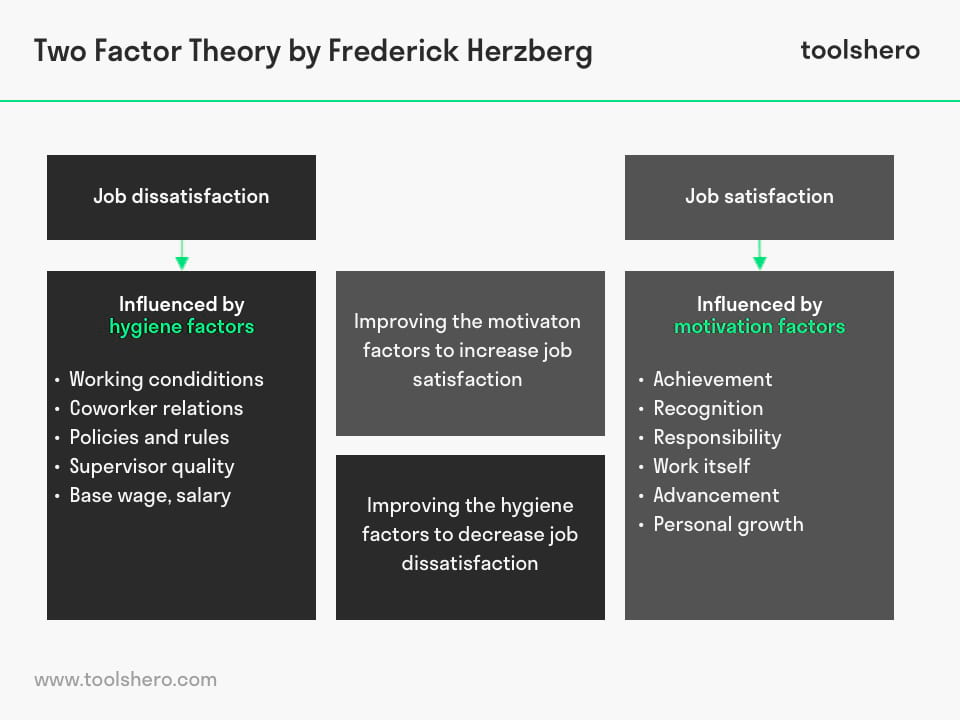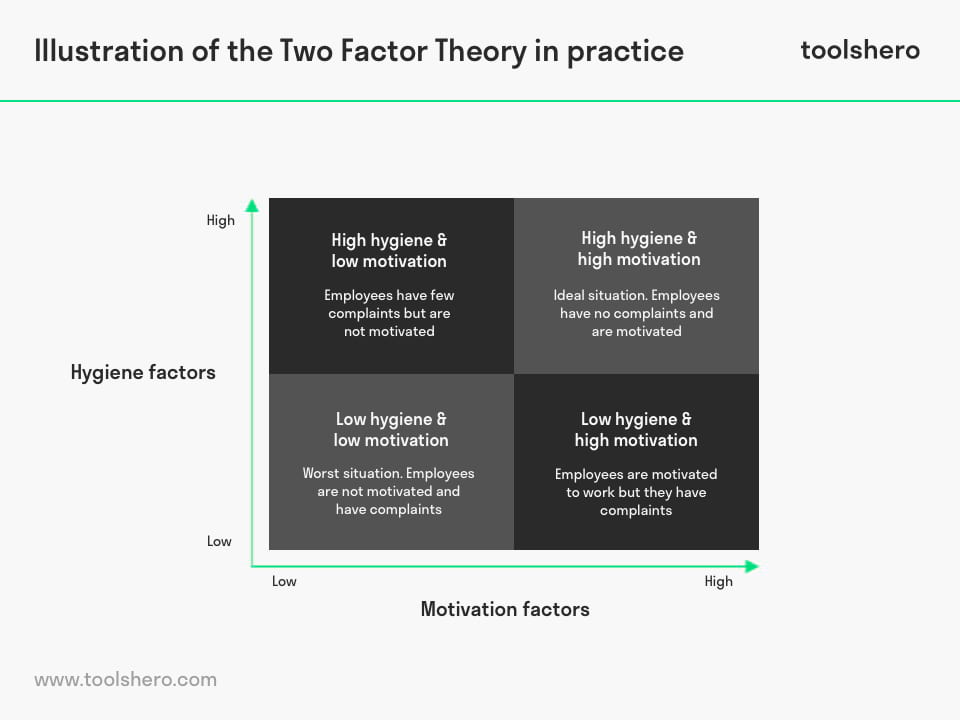Herzberg Two Factor Theory of Motivation

Herzberg Two Factor Theory of Motivation: this article explains the Herzberg Two Factor Theory of Motivation, developed by Frederick Herzberg in a practical way. Next to what this theory is, this article also highlights how to apply this theory, the Critique on the Herzberg Two Factor Theory and a summary with key take aways. After reading it, you understand the core of this effectiveness theory about motivating your employees. Enjoy reading!
What is the Herzberg Two Factor Theory of Motivation?
This theory, also called the Motivation-Hygiene Theory or the dual-factor theory, was penned by Frederick Herzberg in 1959.
This American psychologist Frederick Herzberg, who was very interested in people’s motivation and employees job satisfaction, came up with the theory.
He conducted his research by asking a group of people about their good and bad experiences at work. He was surprised that the group answered questions about their good experiences very differently from the ones about their bad experiences.
Based on this, Frederick Herzberg developed the theory that people’s job satisfaction depends on two kinds of factors. Factors for satisfaction (motivators / satisfiers) and factors for dissatisfaction (hygiene factors / dissatisfiers). Performance, recognition, job status, responsibility and opportunities for growth all fall under motivators/ satisfiers.
Hygiene factors / dissatisfiers are about salary, secondary working conditions, the relationship with colleagues, physical work place and the relationship between supervisor and employee.
In his theory, Frederick Herzberg claims these factors function on the same plane. In other words, satisfaction and dissatisfaction aren’t polar opposites.
Taking away an employee’s dissatisfaction – for example by offering a higher salary – doesn’t necessarily mean the employee will then be satisfied. The employee is just no longer dissatisfied.

Figure 1 – Factors Affecting Motivation
4 different combinations of motivating and hygiene factors can exist at work:
1: High hygiene and high motivation
This is the ideal situation. Employees feel very motivated and barely have any complaints.
2: High hygiene and low motivation
Employees have few complaints, but they’re not really motivated, they see their work simply as a pay check.
3: Low hygiene and high motivation
Employees are motivated, their job is challenging, but they have complaints about salary or work conditions.
4: Low hygiene and low motivation

Figure 2 – Two Factors Theory of Motivation in Practice (Herzberg)
This is the worst possible situation, employees are not motivated and have a lot of complaints.
KITA
Adjusting the hygiene job factors, also called the KITA (Kick in the Ass) factors by Frederick Herzberg, often have a short-term effect that doesn’t last very long.
Changing the motivation factors on the other hand often has a more lasting, long-term effect on employee performance.
How to apply the Herzberg Two Factor Theory of Motivation?
Organisations and their managers want teams with the best possible performance. But how do you motivate that team? There’s not much point in motivating employees if the hygiene factors aren’t taken care off.
Motivating people really works when the things that bother them – the things they complain about -disappear.
Take away the job dissatisfaction
To do this, it’s important to figure out all the important factors first. What are the complaints about, what’s going on, how do the employees interact with each other?
Generally speaking, the following aspects are important:
- Work on the bureaucracy within the organisation (company policy and administrative aspects)
- Make sure there’s supportive and effective supervision
- Create a work environment where all employees are respected
- Pay an honest salary
- Make sure all employees do worthwhile work to build up the status of their functions
- Give job guarantees (job security)
When the dissatisfaction is taken away, the organisation can focus on motivating its employees effectively.
Create conditions for satisfaction
For motivation within the organisation, think about:
- Creating conditions for good performance
- Appreciating your employees’ contributions
- Tailoring the work to your employees’ talents and abilities
- Giving each team as much responsibility as possible
- Offering opportunities for growth within the organisation
- Offering training and development opportunities
Organisations are prone to take Kick In The Ass measures in the short term, because they don’t affect the organisational structure that much.
A higher salary, better work conditions etc. Measures for motivation require bigger investments and changes to the organisational culture.
Critique on the Herzberg Two Factor Theory
The Two Factor Theory is widely used, but there are a few points issues with it. One issue is the fact that humans tend to look at the aspects of their work that they like and project them onto themselves when things are going well. When times are bad, external factors seem to play a larger part.
Another point of criticism is that the Two Factor Theory assumes that job satisfaction equals higher productivity. There are plenty of reasons to disagree, like external factors that might influence productivity. Herzberg didn’t take this into account while researching and coming up with his theory.
Herzberg’s Two Factor Theory has been replaced by many newer theories over time. This is largely due to the above-mentioned critiques. However, Herzberg’s Two Factor Theory is still influential in the methodology of several fields of study. Additionally, Herzberg’s Two Factor Theory still influences new popular management theory.
Summary of the Herzberg Two Factor Theory of Motivation
The Herzberg Two Factor Theory of Motivation is a theory about motivation of employees. This theory assumes on the one hand, that employees can be dissatisfied with their jobs.
This often has something to do with so-called hygiene factors, such as salary and work conditions. On the other hand, employees’ satisfaction has to do with so-called motivation factors. These factors have to do with development opportunities, responsibility and appreciation.
Frederick Herzberg claims these factors exist side by side. Taking away the dissatisfaction factors doesn’t necessarily mean employees will be satisfied. To motivate a team using motivation factors, the hygiene factors need to be taken care of first.
Now it is your turn
What do you think? Could you use the Herzberg Two Factor Theory to motivate your employees a member of your team? How would you approach it? Are you already using the Two Factor Theory and do you have tips and tricks, or would you like to add anything?
Share your experience and knowledge in the comments box below.
More information
- DeShields Jr, O. W., Kara, A., & Kaynak, E. (2005). Determinants of business student satisfaction and retention in higher education: applying Herzberg’s two-factor theory. International journal of educational management, 19(2), 128-139.
- Herzberg, F. (1959). Work and motivation. Behaviour science concepts and management application: Studies in personnel policy, 216.
- Herzberg, F. (1969). Job enrichment pays off. Harvard Business Review, 47(2), 61-78.
- Herzberg, F. (2005). Motivation-hygiene theory. Organizational behavior one: Essential theories of motivation and leadership, eds JB Miner, ME Sharpe Inc, New York, 61-74.
How to cite this article:
Kuijk, A. (2018). Herzberg Two Factor Theory of Motivation. Retrieved [insert date] from Toolshero: https://www.toolshero.com/psychology/two-factor-theory-herzberg/
Published on: 02/20/2018 | Last update: 03/09/2023
Add a link to this page on your website:
<a href=”https://www.toolshero.com/psychology/two-factor-theory-herzberg/”>Toolshero: Herzberg Two Factor Theory of Motivation</a>













20 responses to “Herzberg Two Factor Theory of Motivation”
this is very help full explanation, and great design of answer really amazing.
Thank you for your feedback Anjum. I am glad that you found the article helpful.
Well explained and simplified
Thank you for your feedback. I am glad that you found the article helpful.
I have been looking at this model to assist with understanding the dynamics of anaesthesiologists migration from one working environment to another. the graphics are very useful for helping elucidate these ideas. Please advise me if I may reproduce them in an academic thesis or a published article.
kind regards
Matthew
Thank you for your comment and question, Matthew. Regarding your question, you can reproduce them if you make a reference to our online article (see APA refer). If you have any other questions, please let us know. Kind regards, Vincent
Thank you so much Vincent. I will do so. Much appreciated.
Kind regards
Matthew
Thank you so much this helped me a lot and its explained in a way that make it easier for people to understand, and het the core message from the theory.
Thank you for your comment, Mazyouna.
I like how it was explained , thank you very much it helps a lot in my research
Thank you for your comment, Nadine.
Informative article. What’s the source information?
Useful in understanding Herzerg Theory easily, quickly and to the point
Thank you for your comment, Josiah.
Still in modern era organisations are facing problems related with this theory.
Very useful, easy to pick the point.
That was explained very nicely,easy to understand, I wish i had found this before my exams. Thank you.
Thanks for explaining this theory in detail. Coming to practical application of theory, how many organizations have applied this theory and seen the success. please explain
the topic has been explained so nicely , so it is so clear for me now
thanks
Thank you so much for the well articulated article. I finally understand the theory. Well explained